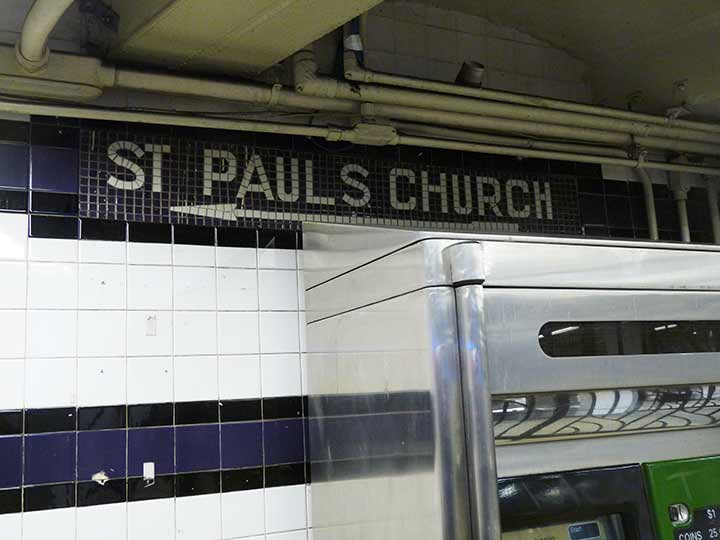
In the mid-1760s, NYC had sufficiently grown that the Episcopalian parish of Trinity Church began to expand uptown, and built St. Paul’s Chapel in 1766. When a giant fire broke out in lower Manhattan in 1776, most buildings in the area were destroyed, but a dedicated group of bucket brigaders kept St. Paul’s from burning down. Today, the new #1 WTC provides a 21st Century contrast to one of the few 18th Century buildings remaining in lower Manhattan. Following the events of 9/11/01, it became a focal point of mourning for the victims of the terrorist attack. The church provided a round-the-clock relief ministry to Ground Zero rescue and recovery workers.
Following the September 11th attacks, it was a miracle that St. Paul’s hadn’t suffered any physical damage. Not even one window had been shattered. The building sat directly across the street from the World Trade Center yet survived unscathed. People started referring to it as “the little chapel that could.”
The church gave credit to a giant sycamore for saving it from damage. The tree stood in the corner of the property, taking the brunt of the debris. Only the church’s organ suffered serious damage, but it was quickly refurbished and put back to use. [911groundzero]
I recently took the E train south to its last stop, World Trade Center, formerly called Chambers Street-Hudson Terminal (the PATH train originates from here, now in the new “Oculus” terminal). Hidden behind the MetroCard machines by the exit was this tiled sign pointing to the church. I’ve become something of an aficionado of the tiled IND directional signs found in mezzanines, placed in the 1930s. However, there’s something a bit off about this one.
The spacing and kerning is a bit uneven, and the lettering doesn’t quite match what the IND did with other stations. A specific font was devised that I have never ascertained the name of, but can identify immediately…and, this ain’t that font. It’s a reasonable facsimile, though, but It says to me that it was designed well after the station opened.
As always, “comment…as you see fit.” I earn a small payment when you click on any ad on the site.
2/24/25


4 comments
I am intimately familiar with this station. Years ago, when I worked at #1 WTC, I used this station on a regular basis travelling to and from Penn Station (LIRR). The station led directly to the WTC concourse so it was easy to pick up a coffee before heading upstairs. Amazingly, it was undamaged on 9/11, just like St. Paul’s. It was closed to the public for quite a while after 9/11.
A few years ago a free transfer was added to the south end, connecting to the BMT Cortlandt St. Station on the R and W. The stations are on the same level and adjacent, so only a wall had to be breached. Since the IND Chambers-WTC already had a free transfer to the IRT Park Place Station, this is one of a few locations (Fulton St., Times Square. 14th St-6th/7th Aves). where the IRT BMT and IND are connected via free transfer. Along with 14th St-6th/7th Aves., PATH is part of the complex as well.
Andy,
Your statements: “A few years ago a free transfer was added to the south end, connecting to the BMT Cortlandt St. Station on the R and W. The stations are on the same level and adjacent, so only a wall had to be breached”. is not correct.
Yes they did add a passageway but the connection between lines is not a free one. It is outside the ‘paid area”. The Cortlandt St station is a full block away on Church St from the Fulton St station which is on Broadway. .Anyone wanting to go from the Fulton St Complex (4, 5, A, C, J, Z) to the R and W train at Cortlandt St would have to exit the turnstiles to get to the passageway and the pay another fare to get to the R and W. In other words it isn’t an “out of system’ transfer (like the 4,5,6 and F, Q at 59th St and 63rd St). The only free transfer added was between the R/W at Cortlandt St and the E train at WTC (via a new passageway at the rear of the downtown R/W platform).
I too am intimately familiar with the station.
Yes, I know that the Fulton Street complex and the BMT Cortlandt St. station are not part of the same fare control, only connected underground outside the turnstile areas. My reference to Fulton St. in my posting is that IRT, BMT, and IND are also connected via free transfer at the Fulton St. complex, a block to the east of the Cortland St. R-W station. My statement is indeed correct – only a wall had to be breached between the E and R/W. Perhaps I was not clear that I was specifically referring to the E-R-W connection only, that opened a few years ago.
During the attacks thousands of people escaped the towers by means of the E train station. As the WTC plaza and surrounding streets were too dangerous because of falling debris (and worse) the authorities directed people down into the concourse and then out through the station.